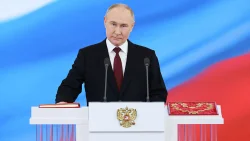🌍 Putin Warns West against Ukraine as NATO Troop Support in Ukraine Escalates
Putin Warns West Against Ukraine
In a strong and unmistakable message, Russian President Vladimir Putin has warned Western powers against increasing military deployments and aid to Ukraine, calling it a “dangerous provocation” that could further destabilize the region.
This warning comes amidst growing reports of NATO’s expanded military support to Kyiv, including advanced weapons, logistics, and troop training. The statement by Putin is seen as a reaction to the escalating tensions and the deepening military alliance between Ukraine and NATO nations.
“Any continued troop build-up or offensive posturing near Russia’s borders will be met with consequences,” Putin said during a press briefing at the Kremlin.
The warning has rattled European allies and drawn immediate international attention, especially as the war in Ukraine enters a critical phase with new counteroffensives in eastern territories.
🔍 Context Behind Putin’s Warning
The Putin warns West against Ukraine troop build-up remark follows NATO’s recent announcement of a multi-billion-dollar defense aid package to Ukraine, along with intelligence-sharing and combat equipment. Countries including the United States, Germany, and the UK have pledged additional troops for training missions and military advisors near the Ukrainian border.
Russia views this as a direct threat to its national security and accuses NATO of crossing a red line by involving itself deeper in what Moscow claims is a regional conflict.
⚠️ What Putin’s Statement Means for Global Stability
Putin’s warning carries significant weight in an already volatile geopolitical climate. The focus keyword — Putin warns West against Ukraine troop build-up — reflects a growing fear that this situation could spiral into a broader European conflict or lead to unintended military confrontations between NATO and Russia.
Analysts believe Putin is attempting to reassert strategic deterrence while signaling that Russia will not tolerate further encroachment near its borders. He accused the West of “fueling the fire” and stated that Russia has the right to respond with “asymmetric measures.”
🔄 NATO’s Response So Far
In response, NATO Secretary-General Jens Stoltenberg reaffirmed the alliance’s commitment to Ukraine, stating that supporting Kyiv is not an escalation, but a defense of international sovereignty and law.
NATO insists that its involvement remains defensive, intended to help Ukraine protect its territorial integrity. However, with both sides ramping up rhetoric and resources, the situation remains tense.
🌐 Global Reactions and What to Expect
Countries like France, Canada, and Japan have called for immediate de-escalation and urged diplomatic dialogue. The United Nations has also expressed concern over the deteriorating situation and urged both parties to return to peace talks.
Military analysts warn that if either side miscalculates, it could lead to an unintended flashpoint in Eastern Europe.

📝 Conclusion: The Stakes Are Rising
As Putin warns West against Ukraine troop build-up, the world watches closely. The standoff is more than just about Ukraine—it’s a test of global alliances, deterrence, and the limits of military diplomacy. Whether it leads to deeper conflict or renewed negotiations will depend on the decisions made in the coming weeks.
For now, what’s certain is this: the geopolitical chessboard is heating up—and both sides are playing for high stakes.
❓ Frequently Asked Questions (FAQ)
1. Why did Putin warn the West?
President Vladimir Putin issued a warning in response to the increased military support by NATO countries to Ukraine, including troop deployments, advanced weapons, and logistical aid. Russia views this as a direct security threat near its borders.
2. What does “Putin warns West against Ukraine troop build-up” really mean?
It signals a strong diplomatic and military message that Russia may retaliate if NATO continues to expand its involvement in Ukraine, potentially leading to increased tensions or even escalation of conflict.
3. What is NATO’s role in Ukraine?
NATO has been providing military aid, training, intelligence sharing, and humanitarian support to Ukraine since the beginning of the conflict in 2022. The alliance claims its actions are defensive, meant to help Ukraine protect its sovereignty.
4. Has NATO deployed troops directly into Ukraine?
No, NATO forces are not officially deployed inside Ukraine. However, NATO members have sent troops to neighboring countries for training and logistical support, and have significantly increased weapons and equipment deliveries to Ukraine.
5. How has Russia reacted to NATO’s support of Ukraine?
Russia has condemned NATO’s involvement as provocative and hostile, arguing that it escalates the war and undermines chances of peace. Putin’s recent statement reflects growing frustration and a warning of potential countermeasures.
6. Could this situation lead to a direct conflict between NATO and Russia?
While unlikely in the immediate future, continued escalation or miscalculation could increase the risk of a larger confrontation, especially if red lines are crossed by either side.
7. What has been the global response to Putin’s warning?
Countries like France, Germany, Canada, and Japan have urged de-escalation and called for diplomatic talks. The United Nations has also expressed concern and emphasized the need for peaceful resolution.
8. What does this mean for the war in Ukraine?
Putin’s warning could signal a hardening of Russia’s position and a more aggressive military strategy. It also raises uncertainty around future peace talks and increases the stakes of international involvement in the conflict.
9. Is this the first time Putin has issued such a warning?
No, Putin has previously warned Western nations, but this latest statement is one of the strongest and most direct warnings since the full-scale war began in 2022.
10. What happens next?
The next steps will depend on NATO’s response and any potential Russian military moves. Analysts predict a critical period ahead, where diplomacy or escalation could reshape the geopolitical balance in Eastern Europe.




